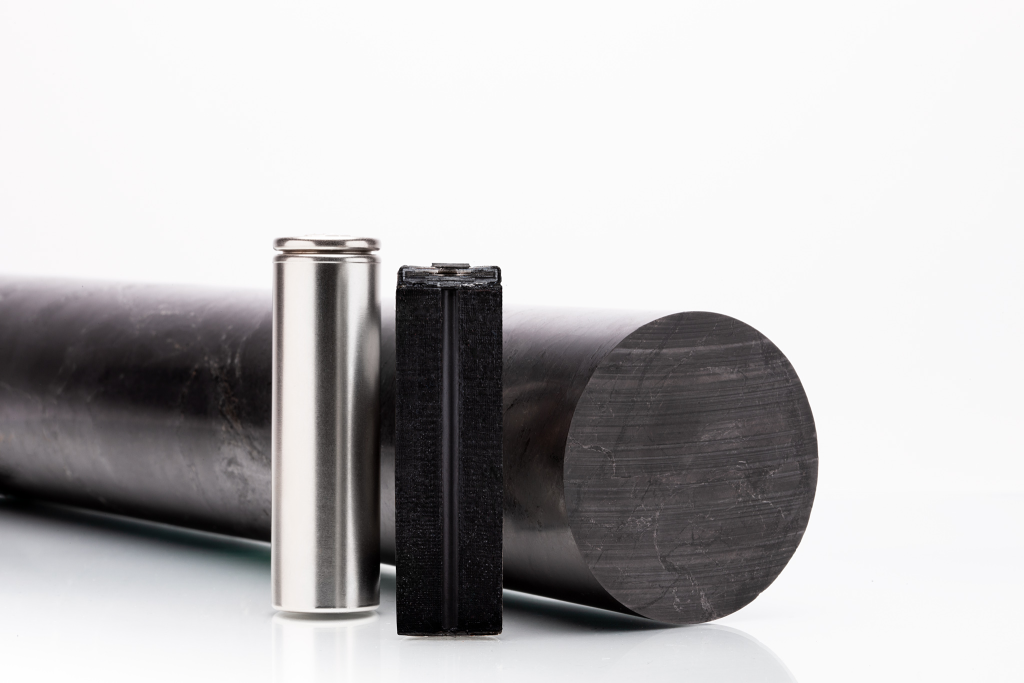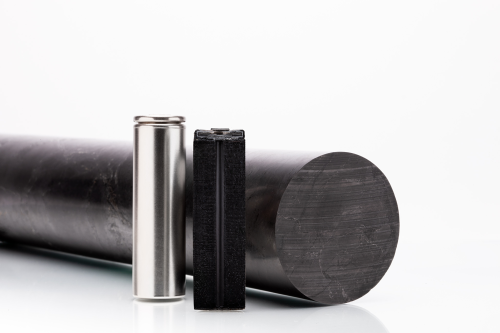1.carbon material
Carbon materials are the most widely used and most common anode materials for commercial use today, mainly including natural graphite, artificial graphite, hard carbon, soft carbon, MCNB (mesocarbon microspheres). Before the next generation of anode materials mature, carbon materials especially However, graphite materials will still be the first choice and mainstream of negative electrode materials.
1.1 Graphite
Graphite is divided into natural graphite and artificial graphite according to the difference between its raw material and processing technology. Because of its low potential for lithium, high initial efficiency, good cycle stability, and low cost, graphite has become an ideal choice for lithium-ion battery applications. Negative material.
Natural graphite: Generally, natural flake graphite is used as raw material, which is modified to make spherical natural graphite for use. Although natural graphite is widely used, there are several disadvantages: ① natural graphite has many surface defects, large specific surface area, and low initial efficiency; ② using PC-based electrolyte, there is a serious co-intercalation phenomenon of solvated lithium ions, which leads to graphite layer expansion Peel off, and the battery performance will fail; ③Natural graphite has strong anisotropy, lithium ions can only be inserted from the end face, and the rate performance is poor and lithium is easily separated.
Modification of natural graphite:
①Aiming at the problems of many surface defects and poor electrolyte tolerance of natural graphite, different surfactants were used for modification. CHENG et al. improved the rate performance of natural graphite by changing the surface of the pore structure and increasing the micropores and lithium intercalation paths on the graphite surface by etching with a strong alkali (KOH) aqueous solution and sintering in a high-temperature oxygen-free atmosphere. WU et al. used different strong oxidant solutions for oxidation treatment to passivate the surface active potential and reducing functional groups to improve the first-time efficiency of natural graphite. MATSUMOTU et al. used ClF3 to fluorinate natural graphite, and found that the charge-discharge rate and cycle life were effectively improved. Another treatment method is to carry out coating modification, and the natural graphite amorphous carbon is coated to construct “core-shell” structure particles. Usually, the carbon source of amorphous carbon is low-temperature pyrolytic carbon materials such as pitch and phenolic resin. The existence of the carbon layer can not only isolate the direct contact of the electrolyte, reduce the surface active points of the particles, and reduce the specific surface area, but also reduce the interfacial impedance and improve the intercalation and diffusion of lithium ions due to the large interlayer spacing of the carbon layer;
②Aiming at the problem of strong anisotropy of natural graphite, mechanical treatment is often used in industrial production to shape the shape of the particles spherically. The airflow shaper uses wind impact to make the particles rub against each other and cut the edges and corners of the particles. This method does not Doping impurities will be introduced, and the spheroidization efficiency is high, but it will cause a large number of particles to be pulverized, and the yield is low. The mechanical fusion machine uses the high-speed rotation of the material in the rotor, clings to the wall of the device under the action of centrifugal force, and passes between the rotor and the stator extrusion head at high speed. At this moment, the material is simultaneously subjected to extrusion force and shear force, and under the action of friction between particles and particles and between particles and equipment, the surface presents a mechanical melting state to achieve the purpose of spherification. Natural graphite has been spheroidized, and the particle size D50 ranges from 15 to 20 μm. The initial efficiency and cycle performance are significantly improved, and the rate performance is greatly improved.
Artificial graphite: It is generally made of dense petroleum coke or needle coke as a precursor, which avoids the surface defects of natural graphite, but still has problems such as poor rate performance due to crystal anisotropy, poor low temperature performance, and easy lithium decomposition when charging.
The modification method of artificial graphite is different from that of natural graphite. Generally, the purpose of reducing the degree of graphite grain orientation (OI value) is achieved through the reorganization of the particle structure. Usually, needle coke precursors with a diameter of 8-10 μm are selected, and easily graphitized materials such as pitch are used as the carbon source of the binder, and processed through a roller furnace to bond several needle coke particles to make a particle size D50 range of 14 ~18μm secondary particles complete graphitization, which effectively reduces the OI value of the material.
1.2 Soft Carbon
Soft carbon, also known as graphitizable carbon material, refers to an amorphous carbon material that can be graphitized at a high temperature above 2500°C. Generally speaking, according to the difference in the sintering temperature of the precursor, soft carbon will produce three different crystal structures, namely amorphous structure, turbulent layer disordered structure and graphite structure. The graphite structure is also the common artificial graphite. Among them, the amorphous structure has attracted extensive attention because of its low crystallinity, large interlayer spacing, and good compatibility with the electrolyte, so it has excellent low-temperature performance and good rate performance.
Soft carbon has high irreversible capacity, low output voltage, and no obvious charge-discharge platform when it is charged and discharged for the first time. Therefore, it is generally not used independently as a negative electrode material, but is usually used as a negative electrode material coating or component. Liu Ping et al. doped a certain proportion of soft carbon in the graphite negative electrode, and found that the low-temperature charging performance of the battery can be improved, and the higher the doping content, the better the low-temperature charging performance, but the cycle performance will decline in the later stage. After experimental demonstration, Doping with 20% soft carbon can achieve a performance balance between low-temperature charging and cycle life.
1.3 Hard carbon
Hard carbon, also known as non-graphitizable carbon material, is also difficult to graphitize at high temperatures above 2500°C. Generally, it is obtained by heat treatment of the precursor in the range of 500-1200°C. Common hard carbons include resin carbon, organic polymer pyrolytic carbon, carbon black, and biomass carbon. Among them, phenolic resin can be pyrolyzed at 800°C to obtain hard carbon materials, and its initial charging capacity can reach 800mAh/g , interlayer spacing d002>0.37nm (graphite is 0.3354nm), large interlayer spacing is conducive to the intercalation and deintercalation of lithium ions, so hard carbon has excellent charge and discharge performance, and is becoming a new research hotspot for negative electrode materials. However, hard carbon has high irreversible capacity for the first time, lagging voltage platform, low compaction density, and easy gas production are also its shortcomings that cannot be ignored. ,
The application of hard carbon mainly considers the matching with the positive electrode material. LIU et al. studied the performance of lithium-ion batteries with lithium-rich materials as the positive electrode material and hard carbon as the negative electrode material, and found that the matching of the two materials can help reduce their respective first irreversible capacity. Lithium-ion batteries prepared by using hard carbon as the negative electrode material and LFP as the positive electrode material by LIAO showed good rate performance and cycle performance, and the capacity retention rate was still more than 60% after 2000 cycles at 10°C.
2.Lithium titanate material
Lithium titanate material: Lithium titanate (LTO) is a composite oxide composed of metallic lithium and low-potential transition metal titanium, which belongs to the spinel solid solution of the AB2X4 series. The theoretical gram capacity of lithium titanate is 175mAh/g, and the actual gram capacity is greater than 160mAh/g. It is one of the negative electrode materials that have been industrialized at present.
Unique advantages:
①Zero strain: the lithium titanate unit cell parameter a=0.836nm, the intercalation and deintercalation of lithium ions during charging and discharging have almost no effect on its crystal structure, avoiding the structural changes caused by material stretching during charging and discharging, thus having extremely High electrochemical stability and cycle life;
② No risk of lithium analysis: Lithium titanate has a potential of up to 1.55V for lithium, no SEI film is formed on the first charge, high initial efficiency, good thermal stability, low interface impedance, excellent low-temperature charging performance, and can be charged at -40°C;
③Three-dimensional fast ion conductor: Lithium titanate is a three-dimensional spinel structure, the intercalation space of lithium is much larger than that of graphite layer, and the ion conductance is an order of magnitude higher than that of graphite material, which is especially suitable for high-rate charge and discharge.
shortcoming:
Lithium titanate also has low battery specific energy due to its low gram capacity and low voltage platform; nano-materials have strong hygroscopicity, resulting in serious high-temperature gas production and poor high-temperature cycles; the material process is complicated and the cost is extremely high, and the cost of the battery cell is the same The energy is more than 3 times that of lithium iron phosphate batteries.
3.Silicon-based materials
Material design: The initial research on nano-silicon carbon materials mainly focused on the low-capacity direction of 400-500mAh/g. There are mainly two types of material structures: core-shell type and embedded type. At the beginning of the design, Li Hong’s team considered increasing the graphite content of the matrix as much as possible to ease the strain of lithium deintercalation and reduce the rebound; in addition, the type, content and sintering process of the surface coating agent were optimized to improve the integrity of the coating layer and introduce liquid phase dispersion. process, improve the uniformity of dispersion, and better play the nano-silicon size effect.
Optimizing the battery chemical system: In addition to material design, the battery chemical system is also optimized by studying binders, conductive agents and electrolytes. The 600-cycle capacity retention rate of 400mAh/g silicon carbon materials is over 80%. On this basis, through optimization Granular structure, developing high power type materials. At present, lithium-ion batteries made of low-capacity materials have been mass-produced in the industry, but from the actual results, the improvement of battery specific energy is extremely limited.
Preparation process of doped nano-silicon: Due to the low graphite content of high-capacity silicon-carbon anodes, the research focus is on the problems of poor cycle stability and poor charge-discharge efficiency caused by the volume expansion of silicon particles, and at the same time, new problems of difficult dispersion and poor processability need to be dealt with . Starting from raw materials, Li Hong’s research group developed a low-cost, high-efficiency doped nano-silicon preparation process, supplemented by gas phase coating, which reduces the specific surface area of the material and improves its surface characteristics and processing performance. It is blended with graphite to make a 500mAh/g negative electrode material, and the compaction density is properly reduced during the application process, and the capacity retention rate of 500 cycles can reach 80%.
Composite material preparation process: Li Hong’s team has also developed a large-scale silicon-carbon composite material preparation process, using a micro-nano composite structure to uniformly disperse nano-silicon in a three-dimensional conductive network. In cooperation with Ningbo Institute of Materials, the negative electrode material of 600mAh/g is made by mixing with graphite, and the lithium-rich phase material is selected for the positive electrode. The energy density of the soft pack battery developed is as high as 374Wh/kg.


